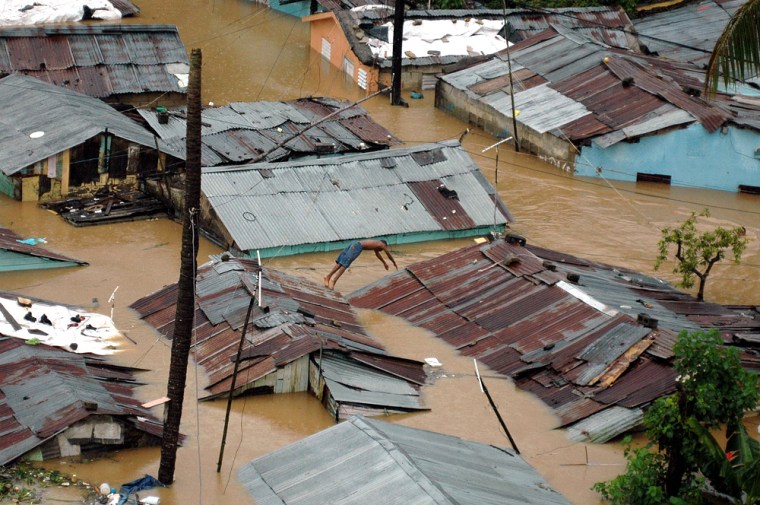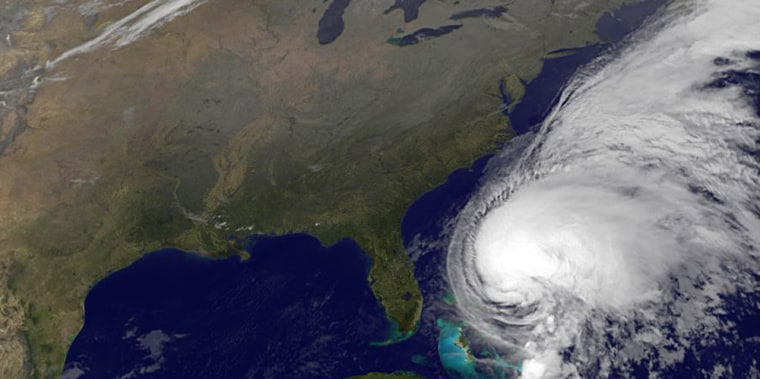Hurricane Noel, the deadliest storm to hit the Atlantic this year, paralleled the U.S. coast on Friday, losing strength as it headed north toward Nova Scotia.
Noel slammed the Caribbean earlier this week with heavy rains that caused flooding and mudslides, leaving 124 dead, officials said.
After drenching the Bahamas and Cuba on Thursday, the Category 1 hurricane’s sustained winds were at 80 mph on Friday and its center was about 425 miles south of Cape Hatteras, N.C., the U.S. National Hurricane Center in Miami said. Noel is moving to the north-northeast at about 17 mph but was expected to pick up speed.
Jack Beven, a hurricane specialist at the center, said Friday that “we don’t expect the center to cross the U.S. coast. The track would take the center of the system over Nova Scotia.”
But Beven also noted that the storm “is going to increase rather significantly in size” and that its effects would be felt in the U.S. Forecasters say 2 to 4 inches of rain could fall in North Carolina’s Outer Banks, while isolated areas of New England might see 6 inches.
U.N. choppers grounded
United Nations helicopters were waiting out driving rain that lashed Haiti on Friday before they could assess flood damage from Noel, then a tropical storm, which killed at least 43 here and left thousands homeless.
The new showers from Noel’s outer bands raised fears of further deaths in a country prone to catastrophic flooding.
The U.N., which has a large peacekeeping force in Haiti, planned to send helicopters to survey flood damage over Haiti’s southern peninsula, which was hit hard by the storm.
But authorities did not know when they might be able to fly. “It just looks like we’re going to have a lot more rain,” said Felix Ronel of the Haitian national meteorological service.
Impoverished Haiti is particularly vulnerable to flooding because people have cut down most of the country’s trees to make charcoal, leaving the hillsides barren and unable to absorb heavy rain.
Dominican Republic dries out
In the Dominican Republic, which shares the island of Hispaniola with Haiti, the rains largely let up, allowing flights carrying urgently needed relief supplies. Authorities in the Dominican Republic confirmed 79 deaths and said at least 62,000 were left homeless by the storm.
The Dominican Republic is not as deforested but also suffers from severe flooding because of its steep mountains and large numbers of people who live in simple homes along its rivers.

Dominican President Leonel Fernandez pledged aid to flood victims, and the government said it had distributed more than 3 million food rations in the hardest hit areas. The first plane to arrive with international donations departed from Panama, carrying 100,000 pounds of relief supplies.
Aid also came from Dominicans like Joel Diaz, a 29-year-old who lives in the outskirts of the capital. “We’re poor, but there are people today who don’t have anything,” he said as he donated clothes and canned food at an emergency management office.
Rain pounds Cuba
Heavy downpours also continued to pound much of eastern Cuba on Friday, and state television reported that more than 30,000 people across the island had been evacuated because of rains associated with Noel. Most were staying with friends and neighbors, according to the military, which used trucks to move citizens to higher ground.
In Guantanamo province at Cuba’s eastern tip, civil defense authorities warned of possible mudslides and reported that 60 percent of roads and highways were damaged or flooded. Electricity and phone service was spotty.
On Thursday, muddy rain-swollen waters overflowed a dam in Cuba, washing into hundreds of homes, over highways and knocking out electricity and telephone service. Dozens of small communities were cut off.
The government said more than 19,800 tons of vegetables had been destroyed by floodwaters and 35,000 acres of farmland were submerged. Many small towns and villages were cut off, especially in mountains of the eastern province of Granma.
